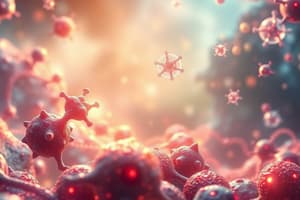Podcast
Questions and Answers
What are carbohydrates primarily composed of?
What are carbohydrates primarily composed of?
- Nucleotides
- Fatty acids
- Amino acids
- Monosaccharides (correct)
Which of the following is NOT a key role of lipids?
Which of the following is NOT a key role of lipids?
- Membrane structure
- Energy storage
- Hormone production
- Transport of oxygen (correct)
What type of reaction is catabolism?
What type of reaction is catabolism?
- Energy storage
- Breakdown of complex molecules (correct)
- Synthesis of complex molecules
- Formation of nucleotides
What structure in enzymes is crucial for catalytic activity?
What structure in enzymes is crucial for catalytic activity?
Which level of protein structure determines its overall three-dimensional shape?
Which level of protein structure determines its overall three-dimensional shape?
What molecule acts as the primary energy currency in cells?
What molecule acts as the primary energy currency in cells?
Which type of biological molecule includes DNA and RNA?
Which type of biological molecule includes DNA and RNA?
What do enzymes do in biological systems?
What do enzymes do in biological systems?
What structure is formed by the association of multiple polypeptide chains?
What structure is formed by the association of multiple polypeptide chains?
Which base pairs with Adenine in DNA?
Which base pairs with Adenine in DNA?
Which process is crucial for energy production in cells?
Which process is crucial for energy production in cells?
In which cell organelle does photosynthesis primarily occur?
In which cell organelle does photosynthesis primarily occur?
What role do coenzymes and cofactors play in enzyme activity?
What role do coenzymes and cofactors play in enzyme activity?
Which factor does NOT influence the regulation of metabolic pathways?
Which factor does NOT influence the regulation of metabolic pathways?
How does biochemistry relate to agriculture?
How does biochemistry relate to agriculture?
What is one application of biochemistry in healthcare?
What is one application of biochemistry in healthcare?
Flashcards
Biochemistry
Biochemistry
The study of chemical processes in living organisms
Carbohydrates
Carbohydrates
Sugars that provide energy and structure
Proteins
Proteins
Chains of amino acids with many functions
Lipids
Lipids
Signup and view all the flashcards
Catabolism
Catabolism
Signup and view all the flashcards
Anabolism
Anabolism
Signup and view all the flashcards
Enzymes
Enzymes
Signup and view all the flashcards
ATP
ATP
Signup and view all the flashcards
Quaternary Structure
Quaternary Structure
Signup and view all the flashcards
DNA Structure
DNA Structure
Signup and view all the flashcards
Cellular Respiration
Cellular Respiration
Signup and view all the flashcards
Photosynthesis
Photosynthesis
Signup and view all the flashcards
Coenzymes/Cofactors
Coenzymes/Cofactors
Signup and view all the flashcards
Metabolic Pathway Regulation
Metabolic Pathway Regulation
Signup and view all the flashcards
Importance of Biochemistry
Importance of Biochemistry
Signup and view all the flashcards
RNA Structure
RNA Structure
Signup and view all the flashcards
Study Notes
Introduction to Biochemistry
- Biochemistry is the study of chemical processes within and relating to living organisms.
- It encompasses the structure, function, and interactions of biological molecules.
- Key areas include metabolism, enzyme catalysis, protein structure and function, and nucleic acid structure and function.
- Biochemistry provides a foundation for understanding biological systems' complexities, from cellular processes to whole organisms.
Biological Molecules
- Carbohydrates: Polymers composed of monosaccharides (simple sugars). Serve as primary energy sources and structural components. Examples include glucose, fructose, and starch.
- Lipids: Diverse group of hydrophobic molecules (insoluble in water). Include fats, oils, phospholipids, and steroids. Key roles in energy storage, membrane structure, and hormones.
- Proteins: Chains of amino acids, crucial for diverse functions, including catalysis (enzymes), transport, structure, and signaling. Their structure (primary, secondary, tertiary, quaternary) impacts function.
- Nucleic Acids: Deoxyribonucleic acid (DNA) and ribonucleic acid (RNA). Store and transmit genetic information. Composed of nucleotides with a sugar-phosphate backbone.
Metabolism
- Catabolism: Breakdown of complex molecules into simpler ones, releasing energy. Examples include glycolysis and the citric acid cycle.
- Anabolism: Synthesis of complex molecules from simpler ones, requiring energy. Examples include protein synthesis and glycogen synthesis.
- Energy transfer: ATP (adenosine triphosphate) is the primary energy currency in cells. It stores and releases energy.
Enzymes
- Biological catalysts: Accelerate chemical reactions without being consumed.
- Specificity: Each enzyme catalyzes specific reactions.
- Active site: Region of the enzyme where the substrate binds, crucial for catalysis.
- Factors affecting enzyme activity: Temperature, pH, substrate concentration, and inhibitors.
Protein Structure and Function
- Amino acid structure: Central carbon atom bonded to an amino group, a carboxyl group, a hydrogen atom, and a variable R group.
- Primary structure: Linear sequence of amino acids in a polypeptide chain.
- Secondary structure: Local folding patterns like α-helices and β-sheets.
- Tertiary structure: Three-dimensional folding of the polypeptide chain, stabilized by interactions between R groups.
- Quaternary structure: Association of multiple polypeptide chains.
Nucleic Acids
- DNA structure: Double helix composed of two antiparallel strands. Base pairing (Adenine-Thymine, Guanine-Cytosine) is crucial.
- RNA structure: Single-stranded molecule, various types with diverse functions (mRNA, tRNA, rRNA).
- Genetic information storage: DNA stores genetic information, which is transcribed into RNA and translated into proteins.
Cellular Respiration
- Aerobic process breaking down glucose to produce ATP. Stages include glycolysis, the Krebs cycle, and the electron transport chain.
- Necessary for energy production in cells.
- Efficiency in energy production varies by pathway.
Photosynthesis
- Anabolic process converting light energy into chemical energy stored in glucose.
- Occurs in chloroplasts, using chlorophyll.
- Light-dependent and light-independent reactions.
- Crucial for providing energy and oxygen for many biological organisms.
Coenzymes and Cofactors
- Non-protein molecules essential for enzyme activity.
- Assist in catalysis: Binding to the enzyme and assisting with the reaction mechanism.
Regulation of Metabolic Pathways
- Cellular control: Regulation ensures that metabolic pathways operate efficiently and respond to cellular needs. Factors like hormones, levels of substrates, and feedback inhibition influence the pathways.
Importance of Biochemistry
- Understanding diseases: Biochemical pathways dysfunction can lead to diseases like diabetes and cancer. Understanding these pathways is critical for developing treatments.
- Biotechnology applications: Biochemistry underpins many biotechnological applications, including genetic engineering and drug development. Tools and knowledge for manipulating biological processes are derived from biochemistry.
- Food science: Understanding the chemical processes within the food system, from digestion to preservation.
- Agriculture: Biochemical processes in plants to improve yield and nutritional value.
Studying That Suits You
Use AI to generate personalized quizzes and flashcards to suit your learning preferences.




